Chasing The World’s Most Beautiful Mountain
Alpamayo was supposed to be easy. Until it wasn't.
Heading out the door? Read this article on the new Outside+ app available now on iOS devices for members! Download the app.
When the cab driver picked us up at 4 a.m. one day last summer, record rains had flooded New York City subways and trapped freeway motorists. In the suburbs north of the city—the embarkation point for Levi Harrell’s and my month-long expedition to the Cordillera Blanca, Peru—cold BBs of rain pelted us slantwise as we struggled to pass our heavy, cumbersome bags over sloshing streams in the roadway. The July storm had already killed at least one person. Still, somehow, our flight hadn’t been canceled.
En route to LaGuardia Airport, I chatted groggily with our cabbie, a paunchy, jaundiced 59-year-old named Noel, about our upcoming adventure.
“Good people, Peruvians,” Noel said in a Brooklyn accent, the repeat Ps popping off his tongue. “Hard workers. Some people confuse them for Mexicans and stuff.” Taken aback by his casual racism, I fell silent, watching the rain streak down the backseat window.
Noel launched into a sermon about the Illuminati. He had important and dangerous information, he said—he couldn’t share details because the Illuminati were watching and listening. Then things got even weirder.
“Everything is God,” Noel said three times, and brought his diatribe to climbing. Against my better judgment, I tuned back in.
“Mountains are God, too,” Noel said. “Think, like, The Ten Commandments.” He meant the 1956 movie. “Moses sees the burning bush—GOD—on a mountain. So mountains are all about God.”
His eyes, piercing, darted to mine in the rearview mirror. “Every time you guys go up into those mountains, I hope you pray. Pray for safe passage.”
I shifted on the cracked leather seats, a faint must of old cigarettes sinking into my clothes, and tried to ignore him. I’m an atheist: I believe in science. If someone told me Chris Sharma was the second coming, I might believe that, too, but that’s all. I try to keep the spiritual at arm’s length, particularly in the mountains. Trusting faith up there is dangerous; faith can get you killed.

“The most beautiful mountain in the world”: A number of mountains—or, rather, their admirers—claim this superlative. It has been used to describe Ama Dablam, Nanda Devi, the Matterhorn, Mount Thor, Ulvetanna.
In the Internet age, Alpamayo (19,511 feet), or “muddy water” to the indigenous Quechua people, is probably singled out as the most beautiful mountain more than any other. It was Levi’s and my main goal for the trip. From the north, it is an immaculate pyramid with a whipped-egg-white sheen. Its other aspects are no less stirring: The flutings of the southwest face have a convergent geometry, each line seemingly pointing toward the summit, like so many arrows.
As far as is known, the first person to call it such on paper was the French mountaineer George Kogan, in his 1954 book, The Ascent of Alpamayo, detailing his, Raymond Leininger, Maurice Lenoir, and Jacques Jongen’s claim to the first ascent, via the North Ridge, in 1951. In actuality, Kogan et al. reached only the north summit, believing it to be the highest point. The true summit, 250 feet higher, was reached by Günter Hauser, Bernhard Huhn, Frieder Knauss, and Horst Wiedmann, all of Germany, three years later.
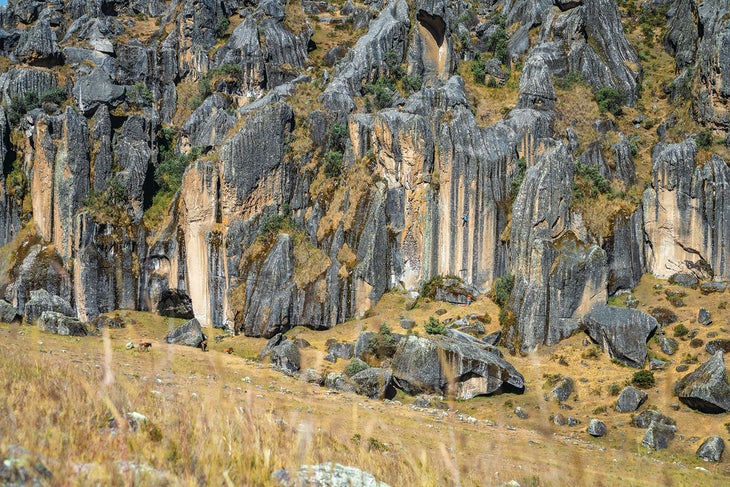
Kogan wrote, on first seeing the mountain, “It is easy to have one’s breath taken away at 18,000 feet. But it was not only the height …. In the same manner, when one morning I caught sight of Chartres, I stood still in silence.”
This was to be my second real expedition, after one to Alaska two years earlier, on which my partner and I failed to summit Mount Huntington. In one attempt, we’d been buried in an avalanche up to our armpits. The trip had been a crash course in expedition planning, expedition execution, and decision-making—not to mention it drained my bank account. This time, I was determined to get to the top. I’d prepared, spending all winter ice climbing and the spring logging miles with a heavy pack. The Elk Mountains in Colorado were perfect: Many of the ice routes have tedious multi-mile, several-thousand-foot-gain approaches.
Joining me was Levi, then 28, a photographer friend I’d worked with during my tenure as an editor at Rock & Ice. A Missouri native with hair so blond it’s nearly white, Levi lives out of his 1989 Ford Econoline van, traveling the country to climb and shoot. He is a former powerlifter (with a one-time max bench press of 325 pounds) who fell in love with rock climbing. His beard is so full as to be Gandalf-esque, appropriate given his Lord of the Rings fandom. He even has an Elvish poem tattooed on his upper back. Levi has a sunny disposition and a Midwestern maxim for every occasion. Though we’d climbed only a few times together, I trusted him to be solid.

Now, after the cab ride with Noel; a five-hour flight to Panama City; a 10-hour layover in the Panama City airport, where Levi and I matched each other beer for beer in a Margaritaville restaurant; another three-and-a-half-hour flight to Lima; and an eight-hour ride to Huaraz—the jumping-off point for Cordillera climbing—on a double-decker bus, our expedition was underway.
“I can’t believe we’re finally doing it,” Levi murmured at each stage. We’d spent six months in anticipation.
On the first afternoon in Huaraz, I climbed up to the top-floor terrace of our Airbnb. It offered a view of the city’s red-ceramic-tiled rooftops and the two ranges that bound it: the barren Cordillera Negra to the west and the white-capped Cordillera Blanca to the east. Each peak in the Blanca is like a tooth: jagged and white and pearly.
“They’re like climbing mini-Himalayan peaks,” Pete Takeda, who has done 13 expeditions to the Cordillera Blanca, told me of the peaks’ steepness and complexity.
Ranrapalca and Churrup and Huandoy and Vallunaraju. To the north, the mighty Huascaran, at 22,205 feet the tallest mountain in Peru, looked 2D, like a Hollywood backdrop. The mountains ringed the city, as limning a caldera, some site of great destruction perhaps. Which was exactly the case.
Earthquakes and landslides—known as huaycos in Quechua—have wrought havoc on Huaraz. An avalanche in 1941 is estimated to have killed 4,000. A massive chunk of Huascaran fell off following a 1970 earthquake. The devastation from that quake and resulting huayco killed 20,000 people in Huaraz; according to Destruction: Archaeological, Philological and Historical Perspectives, by Jan Driessen, only 91 people in the whole city survived. The Huaraz of today was rebuilt atop the ruins of the old city.
As I stood on the balcony in the late-afternoon sunlight, the sun shone softly on Iglesia San Francisco, a rose-hued cathedral across the street. A sheet and a pair of pants fluttered on a nearby laundry line. Two crows bickered on a telephone wire below me.
All was calm.
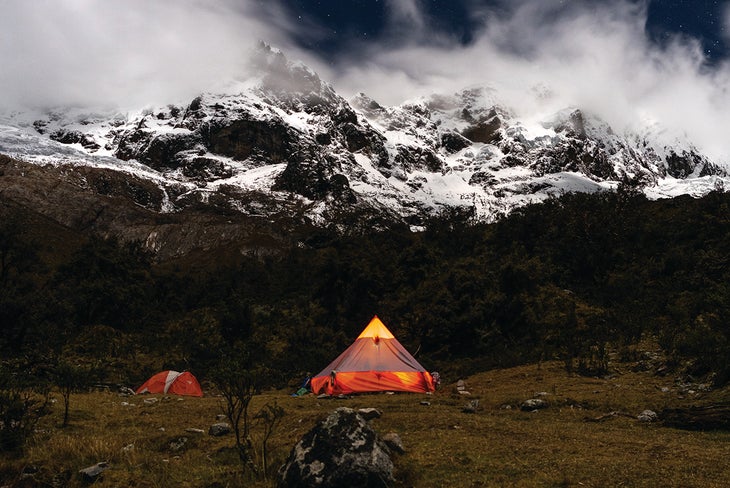
Levi and I acclimatized with a bit of high-altitude sport climbing at Hatun Machay, a rock forest situated at 14,000 feet, two hours south of the city. The only residents are a small community of Quechua shepherds. Climbing 5.10 at that altitude, I felt like I was breathing through a straw, even though I’d spent the last five years living at over 6,000 feet in Colorado.
On our third and final climbing day, a few others showed up: Colin Haley, the American who redefined speed in the Alaska Range when he raced up the Cassin Ridge in eight hours, and three French athletes—the alpinist Lise Billon, the photographer Jan Novak, and Ms. Action Directe herself, Melissa Le Nevé. That afternoon, I roped up with Colin for several pitches. Before attempting Mount Huntington, I’d read the trip report he wrote after the first winter ascent of the peak, with Jed Brown in 2007. Now I asked if he’d ever climbed Alpamayo.
Yes, solo when he was 17, Colin said. “Be careful up there,” he said. “Those cornices are dangerous and unpredictable.”
After two rest and provisioning days in Huaraz, we began our trek up the Santa Cruz Valley toward Alpamayo. We had hired two porters, the brothers Hernán and Fernando Chinchay Quijano. Though several inches shorter than I am—and at 5’5”, I have trouble reaching the top shelf of the kitchen cupboard—Hernán and Fernando shouldered packs verging on 100 pounds. The approach was an ass-kicker: only 15 miles, but 9,000 feet of gain. On the first day, we hiked beside a stream with teal water and churning whirlpools. We made camp at 14,000 feet in a grassy amphitheater with a dilapidated hut used by the arrieros (donkey drivers) and dozens of cows, several of whom stuck their noses into our tent to say hello.
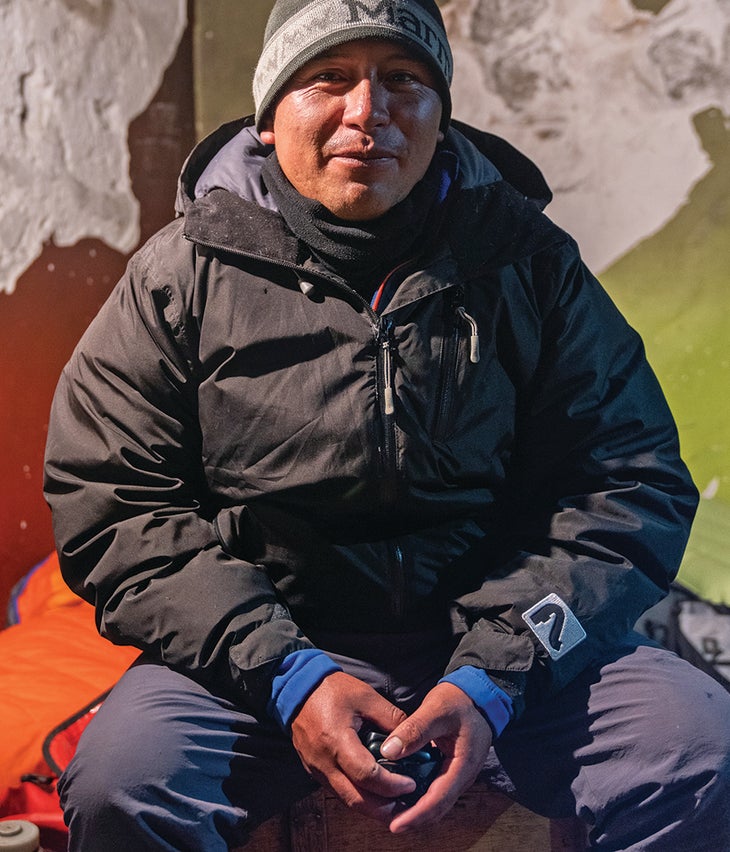
After a rest day at camp, we finally got to use our crampons and tools, climbing several moderate ice and snow pitches through the glacier that leads to the 17,500-foot col between Alpamayo and Quitaraju. Reaching the saddle around 3 p.m., I stopped dead, silent, like Kogan had been exactly 70 years before. We set to work making basecamp at the col, digging out tent platforms and bombproofing everything against the wind.
“What do you think?” I asked Levi as the sky glowed orange at 5:45. “Should we take a run at Alpamayo tomorrow?” Though we’d planned on a rest day, we had a perfect weather window.
“Heck, yes,” Levi said. His scruffy yellow beard still had ice in it from the glacier approach. “We didn’t come all this way for nothing.”
We set our alarms for 1 a.m.
Lying in my sleeping bag, I opened to the napkin bookmark I’d placed in Death in the Andes. Written by Mario Vargas Llosa, a Nobel Prize winner in literature and a onetime candidate for the Peruvian presidency, the novel follows Corporal Lituma, a Peruvian soldier sent to an Andean village to investigate several mysterious disappearances. There he hears stories of mythical vampire-esque monsters called pishtacos, miraculously survives a huayco, and frets that he could be the next to vanish.
In one scene, Lituma meets an anthropologist who explains superstitions like pishtacos by saying the villagers believe in “ancestral gods, the tutelary spirits of the hills and mountains in the Cordillera .… Every peak in the Andes, no matter how small, has its own protective god.” Those gods are called apus. “The apus decide life and death in these regions,” the anthropologist says.
As the winds built up, lashing our tent, I could see why, in such an unforgiving landscape, a culture might turn to higher powers.
The winds only got worse. For hours we felt as if we were in a bomb shelter. When our alarms went off, Levi and I looked at each other knowingly—today wasn’t the day. We peeked out at the mountain silhouetted against a blue-black sky. The face was serene, devoid of spindrift despite the winds.
Again we spent the day preparing, this time breaking trail halfway down the glacier from the col to ease our approach the next morning, and stuffing ourselves with calories.
By 3:30 the next morning, we were walking toward Alpamayo. We’d hoped the wind scouring the glacier would create a firm, weight-bearing crust, but instead we postholed the entire way. The half mile to the base took us a laborious three hours.

As I tied in to lead the first pitch, I found the geography foreign: The face looked nothing like it did from far away, with otherworldly snow gargoyles on both sides of the couloir. But a pickup-truck-sized rock sticking out of the ice halfway up—a landmark we’d picked out from camp—told us we were in the right place. The rising sun, hidden on the mountain’s north side during this austral winter, bruised the southern sky behind us purple. The northern aspects of Quitaraju and Santa Cruz Grande were soon awash with pink.
The first two pitches smacked me down. Low down the couloir wasn’t steep enough to slough off snow, but neither was it mellow enough to plod up. Steep snow is like the offwidth of mountain climbing: punishing and exhausting. I stopped continually to catch my breath, hemming and hawing over picket placements. Four hundred feet up, when I got my first proper ice sticks, I let loose an almighty whoop.
Then, at 18,500 feet, some 1,200 feet above the glacier, the cloudy alpine ice became aerated, as though the face had decided to melt only to change its mind halfway through. There were 50-foot sections of consistent 85-degree terrain—way steeper than I’d expected. I hacked through the surface to reach any ice that would hold body weight. After that pitch, I angled toward a narrow runnel in the left side of the Ferrari couloir, hoping for something more stable. The decision only compounded our difficulties. The surface was still a thick layer of rotten snice, the good ice a foot beneath. I spent long, precious minutes excavating for every screw placement. Each swing and kick sent bucketloads of snow and ice onto Levi, hunkered down amid the bombardment. Two more pitches, and the runnel narrowed. Fins of unconsolidated snow rose on either side, and a snow mushroom reared up in front of me—a blockade. I didn’t dare traverse into the main couloir over the fragile snow fin.
“Levi,” I radioed down after placing a screw.
“What’s up?” the radio crackled back. Levi sounded demoralized.
“Take me tight. I’m going to try to pendulum back right.”
It was my first pendulum in years, and I had no idea if I’d live to regret it, but I tensioned over and found myself on the cleanest, most solid ice of the day. Praise be!
As I finished the pitch, climbing another 120 feet with just three screws, hyperventilating in the thin air, I knew our chances of summiting were dwindling. We’d climbed over 1,200 vertical feet from the glacier, sure, but we still had at least one pitch of technical snow and ice to go. Levi still had to come up, and he was taking as long or longer on each pitch as I had. I looked at my watch: It was 4:30 p.m.; Levi and I had agreed to turn around at 5.
We’re too slow.
Anchored to two screws, I leaned my head against the ice, trying to catch my breath. Wispy clouds drifted lazily over the summit from the north side. A steely sunlight refracted through them. I could see the final snow mushroom. The top looked so close—150 feet, maybe less. The temperature was around 15° F, and getting colder. One hundred and fifty lousy feet. Only half the length of a soccer field. Or the same as a long sport pitch in Rifle, Colorado. On flat ground, we could cover the distance in seconds; on moderate rock, minutes. But here, for us, 150 feet meant hours.
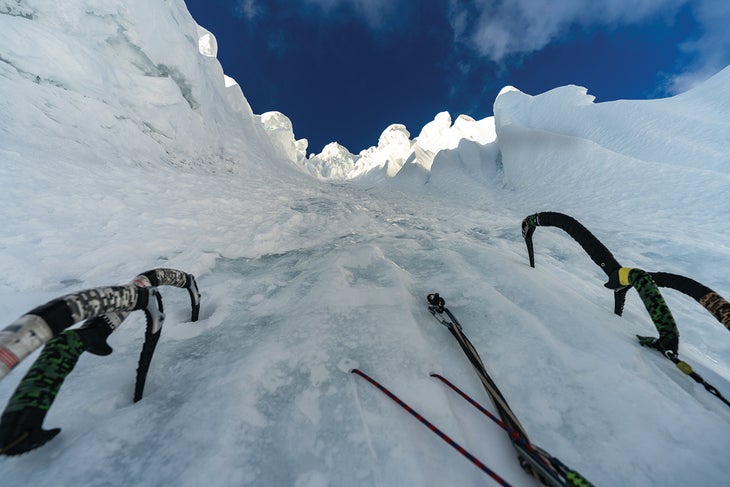
The sky burned red as Levi followed. I had neither drunk enough water nor eaten enough—just an energy bar—all day. By the time Levi reached the belay, I was in a low-level shiver.
“How long do you think it would take us to reach the top?” he asked, buoyed at the sight of the summit.
“Too long,” I told him. No time for debate. We needed to move. The night and cold were harbingers of danger; we had not brought emergency bivy gear.
The first two raps went fine. Digging a solid picket anchor on the third took half an hour. On the fourth, our ropes ended up in a crevasse near the bergschrund, and I had to downclimb 50 feet to free them. My calves were cramping, my gloves wet. The mild shivers morphed into convulsions.
After four hours of rapping, as we finished the final rappel, a cruel joke: Our ropes stuck. No matter what we did, they wouldn’t budge.
“Fuck, dude, let’s just come back and get them tomorrow,” Levi said, his voice thick with exhaustion.
We walked, unroped, like zombies across the glacier, holding our breath across depressions in the snow, hoping we wouldn’t drop into a crevasse. When we stumbled into camp at 11 p.m., Hernán was waiting, having watched our headlamps cross the expanse. After Levi and I forced down two mugs of tea apiece, we went to sleep, unable to catch our breath even lying flat.
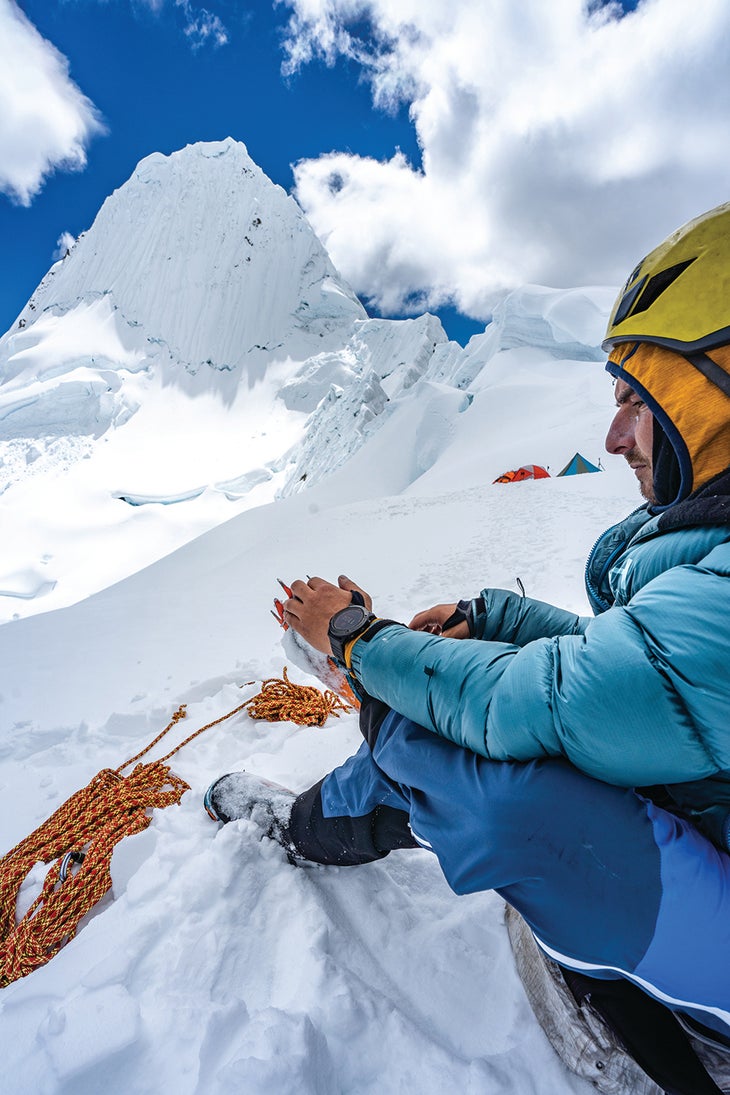
When I woke the next morning, my face was swollen, as though I’d been stung by bees. Edema. Levi was in better shape physically, but said that the walk across the glacier had been too real for him.
“I was in a dark place last night,” he told me. On the way back, he had stumbled and collapsed more than once. He was barely compos mentis when we arrived in camp.
We willed ourselves back across the glacier and retrieved our stuck ropes, packed up camp, and descended several thousand feet. We took an additional rest day below the glacier and lazed with the sun on our bare skin among a grove of polylepis trees.
I was a few pounds lighter when we arrived back in Huaraz, and made it my mission to regain as much of the weight as possible through beer intake alone. But I also hoped to get in a day of rock climbing at a nearby crag. Levi was content to explore Huaraz and edit photos in the Airbnb; he’d had his fill of adventure for the trip. I went to Monkey Wasi, a hostel frequented by climbers, to look up Micher Quito, a local Peruvian guide I had met in the Santa Cruz Valley.
I walked up the stairs to a common area filled with couches, climbing gear, cigarette smoke, and snippets of Polish being spoken. Micher was advising a Polish expedition as to good unclimbed objectives. He came over to say hello. One Pole sat quietly in a large wicker armchair, his back to me. A single dreadlocked rat tail ran down his neck. He turned around as I spoke with Micher, recognizing something in my voice.
This was Adam Bielecki, a Polish alpinist at the vanguard of winter climbing on the world’s 8,000-meter peaks. He had made the first winter ascents of Gasherbrum I (8,080 meters) in 2012 and Broad Peak (8,051 meters) in 2013. He’d attempted the first winter ascent of K2, with another Polish expedition, in 2018. At the same time, two climbers, Elisabeth Revol and Tomek Mackiewicz, completed a first ascent on Nanga Parbat. When Mackiewicz became snowblind on the descent, Revol tried to help him, then was stranded herself. In one of the most daring high-altitude rescues ever, Bielecki and Denis Urubko helicoptered over to Nanga Parbat, sprinted up the lower Kinshofer Route by headlamp, reached Revol in the dead of night, and got her to safety. Revol had left Mackiewicz to shelter in a crevasse at 7,280 meters while she went to get help; he was never seen again.
I’d written about the rescue for Rock & Ice, talking to Bielecki at length over WhatsApp. He was modest and easy-going. I later met him in person in Ladek-Zdroj, Poland, at the 2019 Piolets d’Or. On the final night of the event, I shared a cigarette with him outside a massive party, never expecting to see him again.
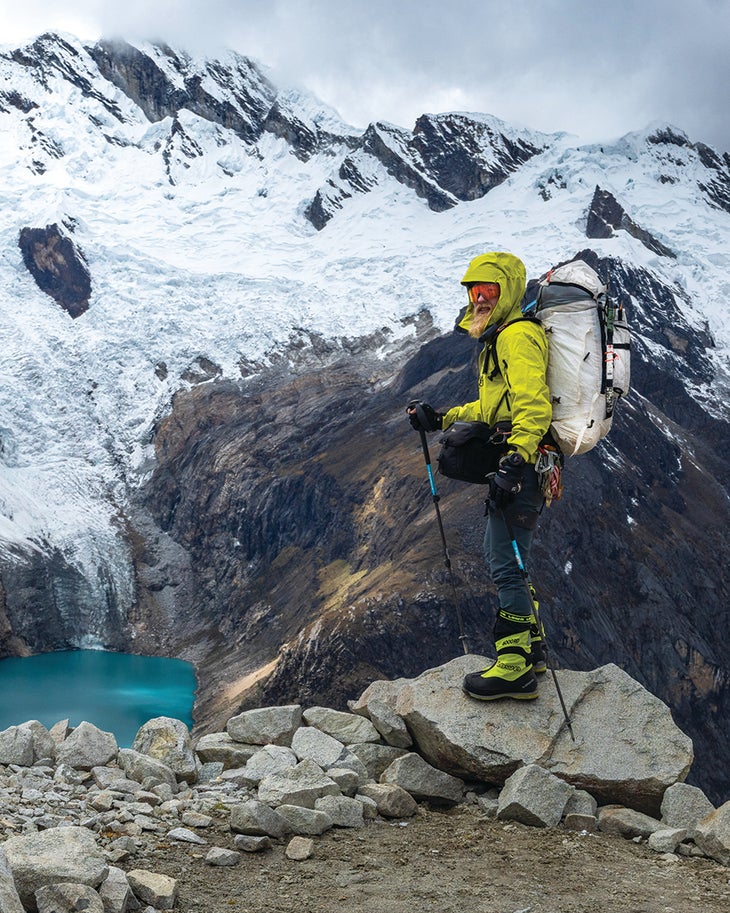
“Adam Bielecki!” I exclaimed that day at Monkey Wasi. I saw alarm in his eyes as he tried to retrieve my name.
“Ryan?” he said, a Hail Mary.
I reintroduced myself, and we caught up. Adam had, he said, joined the Polish expedition here at the last second, thinking he’d find a partner among the many strong members. Unfortunately, everyone was already partnered up.
“I’ve got nothing to do for a few days .… ”
I ventured.
“Yes?” Adam said with a measure of skepticism and hopefulness. “Maybe we can do something.” We kept talking, and I invited him to join Micher and me at the local crag that afternoon.
At the rock, Adam strung up a short 5.11a. I went next—feeling light, strong, acclimated. Whereas 5.11a had felt like 5.12+ in Hatun Machay at the beginning of the trip, now it felt like 5.9. I raced up it.
“That was fast,” Adam said with a small smile. I could see him reevaluating my potential. In Micher’s car on the drive back to Monkey Wasi, Adam slapped my shoulder from the back seat.
“OK, let’s do something!” he said. “Micher can give us an idea, maybe?”
The next day, Adam and I were in a taxi heading up to the Llaca Valley to try a new route on a small mountain called Jangyaraju (18,619 feet). Though far less dramatic than the adjacent Ocshapalca, Jangyaraju had a steep south face with ample room for new lines, Micher had told us. Almost as good, we could approach it in one day, climb it in another, and return to town on the third.
From the trailhead, I gaped at the southwest face of Ranrapalca and the Llaca Glacier sticking its tongue down into its eponymous lake. After hiking up the valley, gaining 800 feet on a gentle slope covered in grassy humps and purple lupines, we came to the remnants of a huayco; it looked as if a gigantic blade had sliced the hillside, wiping out the traditional approach. We stood on a sheer cliff of dirt and mud and rock, empty space stretching for hundreds of meters forward and down. The only way to Jangyaraju now was up over a 50-meter rock wall. Micher had installed a fixed line the year before, and we jugged up it wearing our 60-pound packs.

Adam and I hiked another hour before stopping in a little alpine oasis carpeted in springy alpine tundra and shielded from the wind by a ring of boulders. We made a humble basecamp and had dinner. As night descended, we heard distant thunder—the glacier below Ranrapalca calving. Unseen streamlets braiding and branching throughout the talus, like the gentle clinking of a disturbed crystal chandelier, lulled me to sleep.
At 3 a.m., the alarms jolted us awake; Adam brewed coffee. We drank in silence, took turns eating oatmeal with our one spoon, and started trudging toward the mountain.
Rock slabs led to a glacier riddled with crevasses the size of city canals. In the lead, Adam wove left and right, navigating the maze. Dragging along the surface, the rope broke the crests of tiny penitentes with a sound like shattering glass. We hit several dead ends, and the going was slow. But with one final hairpin turn around the end of a crevasse, we were through: The south face of Jangyaraju reared up in front of us.
Below the bergschrund, we stamped out a stance and organized: Adam racked up with a full complement of cams, nuts, pitons, ice screws, and pickets.
He began traversing up and right, toward a couloir we’d eyed from camp, digging across a snow bridge spanning the bergschrund. With each swipe of his ice tool and plunge of his boot, he sank a bit further. Whumpf! A 50-foot swath of the snow bridge collapsed, and Adam disappeared. I heard frantic swearing from within the glacier. Unharmed, he climbed out and retreated to the belay, but we were both shaken.
Adam gathered himself and set out on a leftward trajectory, toward a series of broken rock buttresses. A possible line snaked in and out of them up the center of the face.
What followed were six pitches of squeaky névé and alpine ice, most of it requiring just a single swing, with the occasional mixed section (to M4). Adam led the first four rope-stretchers, and I took the next two. Whenever I followed his leads, I found myself sucking wind, probably taking almost as long to clean as he had to lead. When Adam followed my pitches, he blitzed up to the anchor.
“God, this is so much fun!” I said to Adam throughout the day, finding—after the spindrift and cold of Alpamayo—pure delight.
Adam took over for pitch seven, a harrowing lead up rock slabs covered with sugar snow. At one point, he nested two micro-cams in a thin crack and yelled down, “I could fall any time!” For the final 20 feet to the ridge, he dug a diagonal tunnel through deeper snow. Two further pitches along a dreamy knife-edge led to the pointy summit.
“Hell yes!” I shouted as Adam took the final steps to the top. I followed, savoring redemption: Huntington and Alpamayo were no longer bitter tastes, but steps along the way to this moment. Adam and I had reached the summit; we’d climbed a new route. We later named it Cita a Ciegas (Blind Date; 500m, D+ M4 70° [85° max]).
The descent looked easy. We had only to walk down the west ridge to a col, then make one or two rappels back to the glacier. But 10 minutes in, we came to a 20-foot cliff of overhanging ice. Digging a bathtub in the snow, I lowered Adam on a hip belay. Now I’d have to build an in-situ anchor for myself.

I spent half an hour digging in the snow, trying to find a good spot for a picket or deadman. I tested at least six or seven, only to have them pull under less than bodyweight. The ridge had been baking in the sun for hours; the snow was like mashed potatoes. Finally, knowing we had to stay ahead of the dark and cold, I got a deadman anchor that looked like it might work. I put the rope into it, took a few steps toward the edge, and leaned back. It held—for a moment.
I was falling.
I landed on my right side on a jumble of ice blocks with a sickening thwack. Pain shot up my hip, and my right ankle—surgically repaired with a metal plate after an ice-climbing accident six months earlier—felt like the screws had all been tightened at once.
“Michael!” Adam yelled. “Are you OK?”
“I think so,” I groaned.
“Did you break anything?”
“No?” I said, unable to believe it myself.
I sat up and looked at the failed anchor lying there next to me. That was too close. I limped toward Adam.
His headlamp dying, Adam cantered down the rocks in the direction of camp, using his poles like extra legs; he wanted to make it back before dark. The last dregs of daylight were fading from the sky. The rest of the ridge, a rappel, and the glacier crossing had been straightforward. Now we just had a couple miles of rock slabs and talus left.
I lumbered along, the discrete pains in my right hip and ankle coalescing into one steady thrum up and down my leg. In minutes, Adam was only a speck on the moraine.
Forty-five minutes later, I was still plodding along, stumbling and slipping on loose scree. It was now dark, but a three-quarters moon and stars cast a pale light over everything. And, I realized with a tingle down the back of my neck, I was disoriented. I stopped and looked around. Had I passed our camp? I felt like I had been walking longer than I should have. I turned my headlamp to its brightest setting, but the night swallowed the beam.
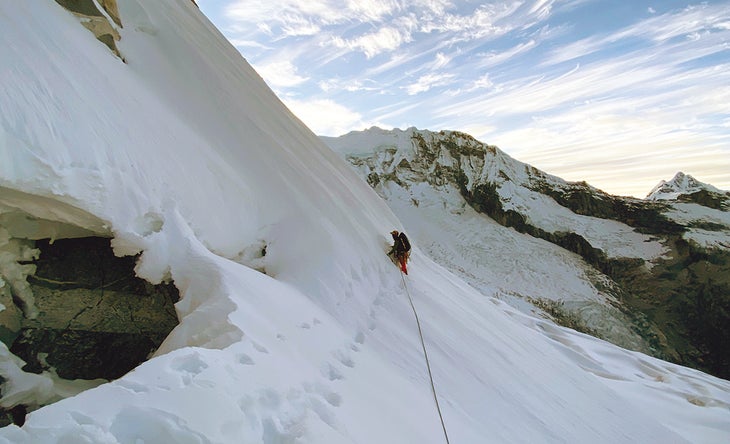
Turning around, I stared back up the moraine toward the toe of the glacier and Jangyaraju. Was that a headlamp above and to the left? If I strained my eyes hard enough at one particular spot, I swore I saw a faint glow bouncing off the walls, like a distant TV flickering. I even thought I saw shadows dancing on the walls. Was I seeing things? Why would Adam be back up on the mountain?
In the span of minutes, I’d switched from feeling relaxed and proud to strung out. If I had to spend a night out alone, I’d probably survive … but would all my toes? Or my fingers?
“ADAM!” I yelled, hoping he’d pop out from behind a rise and ask what all the fuss was about. I pinched my middle finger and thumb together, and blew a shrill whistle. It echoed around the cirque.
I waited, as still as possible. After a few seconds, I yelled Adam’s name again. Glacial meltwater tinkled among the boulders.
The night before heading to Peru, Levi and I had watched Touching the Void, the docu-film adapted from Joe Simpson’s memoir of the same name. During a first ascent on Siula Grande, Simpson broke one leg and injured the other trying to descend, survived a fall into a crevasse, climbed out, and crawled for five miles across the glacier and moraine to safety. The film had seemed an appropriate cautionary tale.
At one point in the film, Simpson, a lapsed Catholic, muses about a thought he had while lying at the bottom of the crevasse: “I always wondered if things really hit the fan, whether I would, under pressure, turn around and say a few Hail Marys and say, ‘Get me out of here.’” Such an entreaty, though, he says, “never once occurred to me. It meant that I really don’t believe. And I really do think that when you die, you die, there’s no afterlife. There’s nothing.”
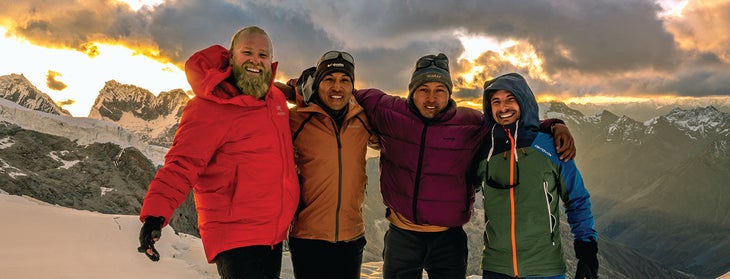
Standing there alone in the Cordillera Blanca, I had no come-to-god moment either.
Still, I prayed for help, silently. I was struck by the awesome power of nature surrounding me. I wanted to sit down, to rest, to close my eyes; I swayed on my feet. Please let me make it through this. Fatigue-addled, I tried to latch onto something. Asking for help out of need—from whom or from what being irrelevant—suddenly made sense. Is prayer directed to no god a prayer at all? Is it a meaningless exhortation? A meditation?
Everything felt like more than I had bargained for. Two climbs had pushed me to my limit and fried my nerves. “Fuck this,” I said aloud, and the sound of a voice, even if only my own, helped to ground me.
I began stewing, thinking of what I’d say to Adam if I ever found him. He had left me. I peered harder into the dark, and finally decided to keep walking downhill. I’d been standing in the same spot for 15 minutes. Action seemed better than inaction.
A boulder shifted under my weight and I landed on my butt with a thud. The scent of flint rose up as heavy rocks banged against each other. I cursed, stood up, and kept going.
And then—a light. Illuminated from within by Adam’s headlamp, the far-off tent was a yellow orb floating in the darkness. It looked like a beacon, as though Adam had found some wood and made a small fire to welcome me in.
I’m safe.
“Is that Michael I hear?” Adam called cheerily from the tent as I clanged into camp 20 minutes later.
“Hey, man,” I said. I slumped onto the damp grass. “Can you roll me a cigarette?”
“I was craving one myself,” he said, throwing open the door.
Ten minutes later, we both sat outside the tent, smoking in silence, gazing at the mountain and the wide band of the Milky Way above.
In Vargas Llosa’s Death in the Andes, Corporal Lituma entertains several different explanations for the deaths of the missing. Near the end of the book, he finally learns the truth: The villagers have banded together for ritual sacrifices to the apus, to placate their mountain gods’ rage. Lituma, who’d earlier been a diehard skeptic, ends up unsure of what to think.
Faith is not an either-or proposition. Like electromagnetic rays, autism, and sexuality, it exists on a spectrum. I still—after our delirious descent on Alpamayo; after my fall descending from Jangyaraju; after Touching the Void in the dark—consider myself a stalwart supporter of science over superstition. I don’t believe I survived anything through divine intervention. But in that moment on the moraine, I needed for anything and everything to be possible. Paying reverence to the deities of a local culture—be they the apus or Shiva, Brahma, and Vishnu—seems like a crucial part of the mountain experience.
But maybe it’s more nuanced. In my dark descent from Jangyaraju, my “prayer,” if anything, was to the inanimate mountains themselves, in acknowledgement that they—and the glaciers and the winds and the rains—are far more powerful than anything else I’ll ever encounter. An avalanche can sweep away a rope team in seconds. Darkness can disorient us. A landslide wipes out a city; a deluge drowns people in their homes. A healthy fear of the elements and their increasing fury in this warming world is vital. A show of humility by praying to nature—whatever form the prayer takes—isn’t a bad thing.
Boarding the plane to the United States after a final marathon bus ride back to Lima, I thanked the mountains for safe passage.
Michael Levy is an editor at large for Climbing.